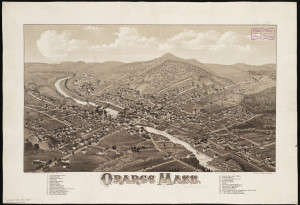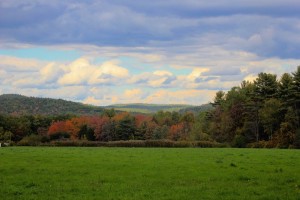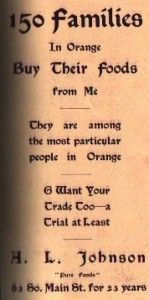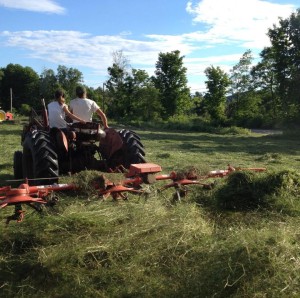
John and Laura Moore met 50 years ago at a 4H gathering in Washington, DC. Both were teenagers from farm families, hers in Michigan, his in Orange, Massachusetts, and they were sent to Washington in recognition of their prize-winning farm products. They fell in love, carried on a long-distance romance, then married and settled down two miles north of the center of Orange on the Cross Road farm where John was raised. They have lived and farmed there ever since, raising four children who still live close by. Their grandchildren are the ninth generation of Moores to live in this part of town.
It is as rural and as pastoral a story as can be imagined. It seems—and the farm feels—very far removed from the center of Orange, in either its industrial heyday or its struggling present. And yet Moore’s Maple Grove Farm has reflected the changes not only in Orange but in the area’s larger industrial economy for well over a century, and the linkages between them challenge us to see the farm and the town as two sides of the same story.
That story began, for the Moores, on another farm a little farther north on Jones Cemetery Road. That was where the first Moores in the area settled not long after the American Revolution. They formed part of a tight-knit network of North Orange farm families for generations, producing, like their neighbors, things that were mainly for their own use but also some for sale in commercial markets: meat, wood, hay, wool, butter. Those markets would mostly have been local ones, and for small farmers like the Moores, the quickly-expanding mill towns along the area’s river valleys provided new venues for their products.

The factories also intersected with the older farm economy in other ways. Good farmland had been hard to come by for many decades, and not all the sons and daughters in farm families were able to move onto farms of their own. Some went west, of course, in the fabled movement toward the frontier. And many moved to the rapidly-growing cities of New England and beyond. But many stayed closer to home, finding work in the mills but not necessarily abandoning their old homes or networks of connection. And the census records show us many examples—perhaps especially in places like north-central Massachusetts, where the mill towns never sprawled into giants and the older farm world was never too far away—of people who moved from one sector to another and sometimes back again, piecing together lives and livelihoods that combined the agricultural and the industrial.
One such family were the Marbles, who came to this area from Northampton around 1895. Alden, Judson, and Joel Marble had grown up on a farm, but seem to have been among those who took non-farming jobs as young men. For Joel, the result was tragic: he died in an accident at the sawmill where he worked, leaving a young wife behind. Alden’s story was equally sad: he married in his mid-twenties and was the father of a three-year-old girl, Mary Charlotte (known as Lottie) when his wife died suddenly of meningitis. Along with their then-widowed mother, this clan of bereaved Northamptonites moved to Orange and Athol together, perhaps seeking a fresh start. The men in the family worked at the New Home Sewing Machine Company in Orange, and Alden remarried when his daughter was 14.

But the Marbles, especially Alden, seem to have been drawn back to farming, and by the turn of the century he and at least one of his brothers had bought the property on Cross Road from an older Orange family, the Goddards. They paid off the mortgage very quickly—an advantage, perhaps, of being able to earn year-round money in the factories.
The Marble brothers didn’t keep the farm long; Lottie Marble was by then being courted by the young John N. Moore from the Jones Cemetery Road family, and it was the young couple who eventually took it over. Their grandson John Moore III tells the story of how the eager young suitor would walk to see his sweetheart, and how the sight of a stand of sugar maples at the edge of the Cross Road farm was his sign that he was almost there. That may have been the reason, John surmises, that after they married in 1903 and settled in at the farm, they renamed it Maple Grove.

Having gone “back to the land,” Alden Marble continued to farm until his death in 1935. He acquired a smaller piece of land between Orange and Athol and may have made a living by selling to some of the many small grocery stores that serviced the two towns by then (numerous small stores appear in the town directories for those decades, along with a few “market gardeners”). John and Lottie Moore ran the Cross Road farm for many years as Maple Grove Dairy, with a substantial sideline in maple syrup. They were one of more than 30 small dairies in Orange who delivered milk to customers’ homes well into the middle of the twentieth century.
By then John’s father, John II, had taken over the running of the farm with his wife Jeannette and eventually with the help of their son John III. Like the Fellows family just to the north in Warwick and the Adamses to the east in Athol, they found as the decades went on that selling liquid milk at a small scale was no longer economically feasible in the age of bulk tank collection, new regulatory hurdles, and increased pressures from larger-scaled companies. After John III took over the active management of the farm in 1999, it didn’t take long to decide that they should make a shift toward more mixed production—the kind, in fact, that both his Moore and Marble forebears would have been very familiar with.
Today, John grows vegetables, raises beef cattle, and sells hay and maple syrup. His wife Laura runs a small bakery, Maple Grove Farmhouse Bakery, in the former Minute Tapioca Factory (now the Orange Innovation Center). Their children work in education and social service, not agriculture, although they help out when needed. Their granddaughter Sienna, now 11, runs her own flower business and helps out in the fields and the bakery at times. Essentially, though, John and Laura point out, their farm and bakery are both one-person operations. It’s not clear whether the long history of Moores farming in North Orange will continue beyond the present generation.

The Moores’ continued presence in local food and farming shows the kind of opportunism and adaptability that small farmers have always needed in order to stay in business in this part of Massachusetts. John, who was taught to drive draft horses when he was just a boy collecting maple syrup with his father and grandfather, did not stop using horses when the family added tractors. As their story shows, members of this family have long seen the industrial towns as both markets and sources of off-farm work. Even the supermarkets that have in many ways made it so difficult for small farmers to compete have served a useful function for the Moores. John’s mother worked in some of the local supermarkets, and although Laura Moore learned to bake in her mother’s kitchen, she honed her business and production skills during years of working at supermarkets in Orange and Greenfield.
And their business draws deeply on long-established relationships with neighbors and family, but also on newer and revitalized networks and ideas. All three generations join together to sell at farmers markets in Athol and Orange; for them, the emergence of “local food” enthusiasm has dovetailed neatly with their own move toward more diverse offerings. They have also embraced farmland preservation strategies, protecting their more than 400 acres with the help of Mount Grace Land Conservation Trust. Whatever direction the younger generations of Moores take from here, the land will remain in agricultural production.
As the area’s mill towns continue to try to redefine themselves, farms like this one may well have an important role to play, knitting agriculture more fully back into a story dominated for many decades by empty factory buildings and persistent economic struggles. Seeing the farms and the factories as two sides of the same coin perhaps opens the way to a vision of a more hybrid and locally-rooted economy that draws on the strengths of its people and the land they share.
Click here for a gallery of additional photos from the Moore family.